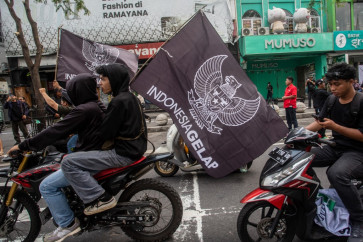Popular Reads
Top Results
Can't find what you're looking for?
View all search resultsPopular Reads
Top Results
Can't find what you're looking for?
View all search resultsMore concern over bird flu virus
A senior Health Ministry official on Tuesday dismissed fears of a virus reassortment between avian and human seasonal influenza strains in a 2007 human death involving bird flu infection
Change text size
Gift Premium Articles
to Anyone
A senior Health Ministry official on Tuesday dismissed fears of a virus reassortment between avian and human seasonal influenza strains in a 2007 human death involving bird flu infection.
Director General of Communicable Diseases I Nyoman Kandun said the possibility of reassortment between the avian influenza virus -- H5N1 -- and other flu viruses was always possible, but had not yet happened.
"When and where it will happen, nobody knows. Risk assessment therefore is very important," Kandun said.
Reassortment of the highly pathogenic avian influenza and seasonal flu virus would give birth to a "new" virus that could be easily transmitted from human to human, resulting in a pandemic.
Scientific journal Cidrap has quoted researcher Vivi Setiawaty of the Center for Biomedical and Pharmaceutical Research and Development as saying a 16-year-old Indonesian girl died of co-infection between seasonal and avian strains of influenza in April 2007.
The girl tested positive for flu under the Health Ministry's flu-surveillance system, which was established in 2005 shortly after the country reported its first bird flu infection in a human.
The girl had shown flu symptoms for several days before she was treated for an infectious disease in East Jakarta. She was reported to have mild symptoms, including sore throat, cough and body aches, but displayed neither respiratory problems nor signs of pneumonia.
Throat and nasal-swab samples that were taken on the sixth day of her symptoms tested positive by reverse-transcriptase polymerase chain reaction (RT-PCR) for both avian influenza H5N1 and the seasonal flu strain H3N2.
The test results were confirmed by the Eijkman Institute for Molecular Biology in Jakarta.
Cidrap said the girl's case occurred within the period when the Indonesian government ceased sharing flu isolates with the international laboratory overseen by the World Health Organization.
"Such infections are of great concern due to the possibility of genetic reassortment leading to the emergence of a H5N1 strain that is more easily transmitted human to human, and emphasizes the importance of advanced laboratory-based surveillance in geographic regions where both human and avian influenza viruses are co-circulating," Cidrap reported.
Asked about the finding, Kandun said Indonesia needed to strengthen its surveillance system, including laboratory capacity.
A virologist and microbiologist at Udayana University in Denpasar, I Gusti Ngurah Mahardhika, said the co-infection involving the girl most likely was not the first such case in Indonesia because researchers used to focus only on H5N1 and did not check for the presence of other H viruses.
"Global fear of a new virus from such a co-infection is well grounded, I think. The product of a reassortment between H5N1 and H3N2 can be still in the form of H5N1 but with traits of H3N2. The new H5N1 is virulent and has the capacity to transmit from human to human like H3N2, our seasonal flu virus," he said.










